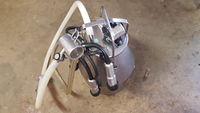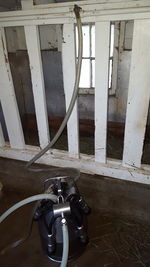Jacob Springs Farm:Milking procedures
Preparation
- Assemble claw and lid; affix to milking bucket. (x2.)
- Make sure there are clean jars, lids and rings available for later pouring.
- Prepare cleaning supplies to take into the milking parlour:
- Fill Udder Wash bucket with hot water and add a capful of FC-98 Sanitizing Udder Wash.
- Swish cap in hot water to clean it before putting back on container.
- Get 2 dairy rags. One goes into the udder wash and one will be used for drying.
- Take milking cans and udder wash bucket to milking parlour. Carry larger can on round, red barrel dolly.
- Check manger for chicken eggs and place any found in a basket from the barn.
- Set milking can and stool between first two stalls on the left. Attach air hose to bucket.
Moving Cows: Pasture to Parlour
Halters and leads are used to transport cows to and from the pasture.
- Retrieve leads from back of the milking parlour.
- If a temporary electric fence is being used, turn off electric fence surrounding pasture
- Put halters and leads on Daisy, Belle, and Henna. Just a lead goes around Veronica’s horns.
- Open fence (untie/unhook and set out of the way so cows don’t step on or over the tape)
- Walk cows across the property to the parlour, maintaining a cohesive, herd-like unit.
- Put Veronica in 1st stanchion (the stall closet to the door), Belle in 2nd, Daisy in 3rd, Henna in 4th.
- Give the cows the proper grain ration: 1 pound of grain for every 4 pounds (or half gallon) of milk she is producing up to a limit of 5 lbs of grain
Teat Cleaning: WDS
-Wash: Using wet rag out of Udder Wash, thoroughly clean each teat. Check orifice on bottom of teat for any dirt.
-Dry: each teat with the dry cloth.
-Strip: milk from each teat into your hand (one at a time) and check for good color and any indication of a problem, i.e. crystals in the milk. This also clears the teat orifice.
Milking
Remove claw from the hook on the bucket. Be sure the air and milk tubes are facing toward the bucket. Listen for clicking from the pulsator.
Kink 3 of the inflations to block air flow, and open the valve.
Kink the 4th inflation and release it on to the corresponding teat. If you have proper suction, it will draw up the teat on its own.
Repeat this with remaining inflations/teats.
Note: if you hear a sucking or slurping noise, the inflation is not on the teat correctly, or the teat is empty. The friction from the inflation will cause chafing and chapping, or could precede the claw coming off the teats completely, so tend to this quickly.
Watch the flow of milk in the tube. When it slows down, manually compress udder from top down to help drain. Squeeze firmly at the top by placing your hands on opposite sides of the udder and pull down toward teats (be careful to not squeeze and send milk back up into udder). Repeat as necessary.
Once no more milk is flowing, close valve and remove from teats. Raise tubing and open valve to drain milk into bucket, then hang claw on hook.
While first cow is being milked, wash and start milking cow in third stanchion using same procedures.
Remove air hose and weigh the can on the scale in the back room.
Return bucket and reattach air hose. Repeat cleaning, milking, and weighing for next cow.
After milking and weighing milk from first two cows, give each cow a second scoop of grain.
Repeat process until all cows have been milked and cans have been weighed.
Once finished, turn off pump and return cows to pasture.
Take the milk bucket and udder wash back to the farm kitchen. Pour milk into half gallon bottles, wipe clean, put lids and rings on and put bottles in sink with running cold water to cool. Make note of the time bottles start cooling. Keep water running for 10 minutes, then shut off water and add as many ice packs as will fit.
Rinse claw and lid with hot water to prevent milk drying inside.
Equipment Cleaning Procedures
-Put on cleaning gloves (marked for dairy use)
-Fill a sink with 2-3 gallons of hot water. Place ¼ cup FC509 In the sink as it fills and swish around with water to dissolve.
-Dismantle the lid, set pulsator aside.
-Take apart all other apparatus and place in sink.
-Scrub each part with a brush and run plenty of water through tubing.
-Put a scoop of water (use large yogurt container) into milking bucket and scrub the bucket inside and out.
-Drain sink, then refill with 2-3 gallons lukewarm water.
-Place the measuring cup with 8ml FC350 (acid) into the water and gently swish. Avoid splashing the acid anywhere.
-Repeat scrubbing and washing procedure on all equipment.
-Drain sink and rinse everything with hot water.
-Set or hang all pieces to air dry.
Customer Prep
-After milk has cooled 1½ to 2 hours, remove from sink and wipe dry.
-Look up that day’s orders. Prep jars by placing name magnets on lids.
-Move any bottles from the cooling tray in the refrigerator to top shelf for customer pick up.
-If there is extra milk after filling orders, label jars with day of the week.
-Put thawed ice packs in the freezer after wiping dry.
-Put fresh ice packs in between bottles in the cooling tray to continue cooling process.
Clean Milking Parlour:
-Clean up floor as needed (broom is in back half of the parlour.)
-If there is urine on the floor, sweep to drain with broom.
-If there is fecal matter, use a small amount of soapy water on the floor, brush thoroughly, and sweep to drain.
-If there is a large amount of water pooling outside the barn door, sweep away to disperse for better drying.
-If water was used, leave barn door open for air circulation.
-Turn off light.
WEEKLY:
Pull windows from claws and use bottle brushes to clean thoroughly.
Refrigerated Cooling Tray:
-Empty all water from tray
-Wipe down inside
-Refill with cold water
-Return to refrigerator
Change out milking lid and claw
Power Wash Kitchen Floor
Power Wash Milking Parlor
MONTHLY:
Clean all milk tubing with scraper and brush.

